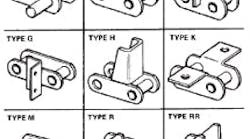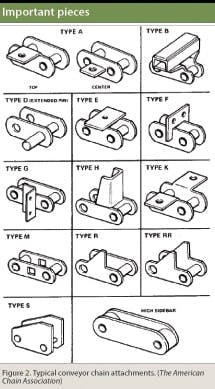Everyone I know wants to buy a product at the lowest possible initial price and they want it to last a long time. It’s no different for a plant that uses chain conveyors. Purchasing departments seek the best price on any chain they buy. Maintenance groups try to keep those chains running as long as possible.
Several chain manufacturers provide standard chains and competition keeps prices low. Those same manufacturers provide plenty of good maintenance information for standard chains at little or no cost. So, purchasing departments can buy standard conveyor chains at low prices. And maintenance organizations can keep those conveyors chains running by following simple and inexpensive guidelines. In many cases, everyone gets what they want by using standard conveyor chains.
Rollers and sliders
Two standard conveyor chain types are considered here. Both have straight-edged link plates, or sidebars. One type has small diameter rollers, or no rollers and the link plate edges of these chains slide on ways or guides when they are operating. OK, not all conveyor chains roll, but they’re an important part of conveyor chain usage. The chains that slide conform to American National Standards ASME B29.4 (Figure 1a) or B29.12 (Figure 1b).
The second type has rollers that are larger in diameter than the height of the link plates or sidebars, and the rollers of these chains roll on ways or guides when they are operating. These conveyor chains conform to American National Standards ASME B29.4 (Figure 1c) or B29.15 (Figure 1d). The pitch on ASME B29.4 chains ranges from 1.0 in. to 4.0 in. The pitch on ASME B29.12 chains ranges from 2.609 in. to 7.0 in. And the pitch of ASME B29.15 chains is from 3.0 in. to 6.0 in. Minimum tensile strengths range from 3,125 lb. for the C2040 chain in B29.4 to 155,000 lb. for the S864 chain in B29.12. Chain manufacturers offer many non-standard variants, but they work very much like the standard chains in service.
Many types of attachments are available for these chains (Figure 2). The user can then mount a variety of carriers on the attachments. As a result, these standard conveyor chains serve a large number of material-handling needs. And because they’re standard chains, their cost is usually lower than a special made-to-order chain.
Important pieces
Chain manufacturers also produce a large number of special conveyor chains. Many of these run over standard sprockets but use special lubricants, coatings, materials and design features to provide longer service life in adverse conditions. When chain features are well matched to the application, these specialized chains often are well worth their added cost. But, in many cases, properly lubricating and maintaining a standard chain in service will be more economical in the long run.
Align during installation
Many manufacturers provide good guidance for installing their chains. And, the book, “Standard Handbook of Chains,” by the American Chain Assn., gives more helpful information. But, these usually have only the basics. A few steps need extra attention.
Be sure to align the sprockets and tracks, or ways, correctly. Align the head shaft and tail shaft sprockets with each other as closely as practical. It’s best to use standard laser alignment tools to ensure the tracks are well-aligned with the sprockets, but the older method, using piano wire, also works well.
Ensure that the shafts are perpendicular to the chain path. This is especially important with multistrand conveyors that have chains some distance apart. If the conveyor normally is heavily loaded, verify the sprocket alignment under load because high loads can flex machine parts and force them out of alignment. Multiple chains intended to run in parallel often are supplied in matched sets. Be sure to install such chains in the correct order to avoid erratic operation and chain component breakage.
Set the initial tension correctly. Chains that are too tight can run hot and wear faster. Chains that are too loose can be noisy and operate roughly. Also, if the conveyor is expected to operate heavily loaded, ask the supplier for data showing how much the chains elongate with load. A heavily loaded chain might elongate so much that it becomes loose. That is possible even if the initial chain tension is set correctly at idle.
Lubricate along tracks
Conveyor chains must have proper lubrication to achieve long and reliable service. In conveyor chains, proper lubrication while between sprockets is often more important than when the chain engages the sprockets. While it’s obvious that sliding-surface lubrication is important when the sidebar edges slide on tracks, it’s less obvious that one needs to lubricate the bushing OD and roller ID surfaces when the chain rollers travel on the tracks.
If the sidebars slide on tracks, apply lubricant along the entire length of the track itself. Applying lubricant to the chain leaves most of the track un-lubricated. Use grease that is thick enough to stay on the tracks under expected operating conditions. These greases sometimes contain extreme-pressure and anti-oxidizing additives. If operating conditions permit, use tracks made of a lubricant-impregnated material or a low-friction polymer. Feed just a small amount of oil between the inner and outer sidebars so that it can flow freely into the chain joints to smooth engagement with the sprockets.
If the chain rollers roll on the tracks, keep the tracks relatively dry. It’s most important to feed oil between the inside sidebars and the rollers so it can reach the bearing surfaces between the roller ID and the bushing OD. The oil should be thin enough to flow readily into the hidden bearing areas but thick enough to form a durable lubricating film. These oils also sometimes contain extreme-pressure and antioxidizing additives. Here again, you only need to feed a small amount of oil into the chain joints to smooth engagement with the sprockets.
For manual application, brush grease onto the tracks and brush or drip oil onto the chain immediately after the conveyor stops. If you prefer automatic oilers, apply oil to the conveyor chain soon after it leaves the head shaft (driver) sprocket. The chain is under low tension at that point, which gives the oil the best opportunity to flow freely into the joints.
Check the chain manufacturer’s bulletins, query the grease supplier and consult the “Standard Handbook of Chains” for help in picking the oil to lubricate the rollers, chain joints and conveyor tracks. Table 1 shows the suggested lube viscosity as a function of temperature. But don’t use Table 1 alone. Contact chain and lubricant suppliers for additional guidance. Many conveyor chains must operate in conditions that make good lubrication difficult. The chain and lubricant suppliers might have experience with those conditions and know how to handle them.
|
Temperature range |
Suggested |
|
-50 to +50 |
SAE 5 |
|
-20 to +80 |
SAE 10 |
|
+10 to +110 |
SAE 20 |
|
+20 to +130 |
SAE 30 |
|
+30 to +140 |
SAE 40 |
|
+40 to +150 |
SAE 50 |
Table 1. Suggested oil viscosity as a function of operating temperature. When the temperature range permits a choice, use the heavier grade. |
|
It does no good to apply oil to a dirty chain. In fact, it might do harm if the lube carries abrasive dirt into the chain joints. That’s why it’s considered a best practice to clean the chain before applying fresh lubricant. If possible, remove the chain and dip it in a solvent to remove dirt and debris. Otherwise, wipe down the chain with a rag and solvent or fuel oil before oiling the chain manually. Clean the chain with stationary or rotating brushes just before it passes an automatic oiler. Ask lubrication equipment suppliers for help in selecting a good system for your application.
Inspect and correct
Many maintenance organizations schedule downtime for conveyor maintenance. They find that this disruption is less costly than repairing breakdowns that lose more production time.
The most important part of conveyor chain maintenance is inspection and correction. The goal is to find problems and correct them before the conveyor breaks down. Manufacturers’ bulletins and the “Standard Handbook of Chains” have good checklists for inspecting and correcting chain conveyor problems. It’s up to maintenance personnel to consider the available resources and use them consistently.
It’s important to repeat that the main reason for planned chain conveyor maintenance is to verify that the chain is getting proper lubrication. If manual lubrication is used, carefully clean the tracks and chain and apply suitable grease or oil. If automatic lubrication is used, clean the chain and tracks and make sure the automatic oiler is operating as it should.
It also is worth repeating two other planned maintenance items. One is to check and, if needed, reset the initial tension, or chain sag. The other is to check and, if needed, reset the track and sprocket alignment.
This has been a necessarily brief overview of conveyor chain care. Much more information is contained in the reference and in manufacturers’ bulletins. Take full advantage of the knowledge and experience that chain suppliers possess. Many plant professionals find that selecting and properly caring for a standard conveyor chain is the most economical answer to their needs. If operating conditions are dirty, wet or corrosive, by all means, consider one of the specialty chains. But, in most cases, it’s worthwhile to take a hard look at using standard chains first. And then plan to take good care of those chains.
Reference:
American Chain Association, Standard Handbook of Chains, Chains for Power Transmission and Material-Handling, 2nd Edition, CRC Press, Boca Raton, 2006.
John L. Wright is a technical consultant specializing in chain technology who lives in Indianapolis. Contact him at [email protected] and (317) 783-2636.


